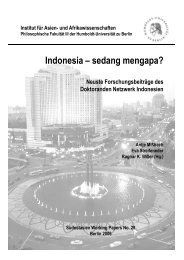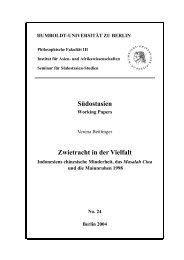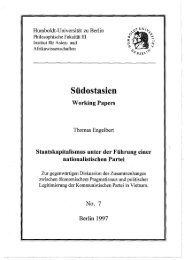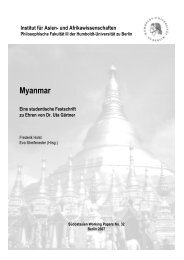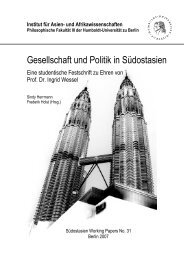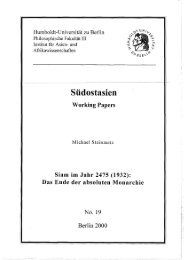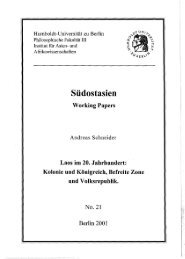On Centrism and Dualism - Humboldt-Universität zu Berlin
On Centrism and Dualism - Humboldt-Universität zu Berlin
On Centrism and Dualism - Humboldt-Universität zu Berlin
You also want an ePaper? Increase the reach of your titles
YUMPU automatically turns print PDFs into web optimized ePapers that Google loves.
CENTRISM AND DUALISM<br />
arose due to the lack of fit of “house society” within the existing taxonomy used to divide societies<br />
into different types (GILLESPIE 2000b: 40 original italics).<br />
A further problem regarding anthropological typology, is that LÉVI-STRAUSS’ conception, in<br />
which the house is perceived to blur traditional but now indefensible kinship categories <strong>and</strong> to<br />
span what is actually a continuum from unilineal to cognatic principles, would, in fact,<br />
encompass most of the world’s known societies. 76<br />
This classificatory problem is epitomized by the fact that scholars such as CARSTEN, GIBSON,<br />
<strong>and</strong> HOWELL all point out, that there is some confusion whether we are to consider the<br />
cognatic societies of Indonesia or those with descent groups <strong>and</strong> asymmetrical alliance, as<br />
paradigmatic of LÉVI-STRAUSS’ ‘type’ (CARSTEN/HUGH-JONES 1995: 18).<br />
For Signe HOWELL (1995), LÉVI-STRAUSS does himself a disservice by including in his<br />
category of house(-based) societies a r<strong>and</strong>om selection of societies predicated upon very<br />
different ideological constructs, just because the house is of prominent social <strong>and</strong> symbolic<br />
significance. She points out that, as a result of including both ‘types’ of Indonesian societies<br />
in his analyses, the analysis of both societies would suffer (ibid.: 150). 77 Because LÉVI-<br />
STRAUSS, himself, applied his concept of house in such a broad variability of contexts, it is<br />
commonly seen as having no typological value.<br />
These problems expose a great conceptual dilemma of typological orientation to social<br />
organization. In many typological approaches, societies <strong>and</strong> their constituent units are<br />
classified into what are presumed to be mutually exclusive essentialist types, defined on the<br />
basis of one feature or a constellation of features, to be compared <strong>and</strong> contrasted on that basis.<br />
PFEFFER (1992) emphasizes the importance of culture-specific forms of classifications in<br />
anthropological approaches that seek to investigate ‘meaningfulness in a cross-cultural<br />
comparison’ (PFEFFER 1992: 43). These culture-specific forms must be comprehended as<br />
constituting wholes. This holistic approach concentrates on elements <strong>and</strong> their relationships in<br />
a specific cultural order that has to be compared as a whole to other such wholes. When<br />
anthropology’s task is understood as the cross-cultural comparison of meaningfulness then<br />
any attempt of defining universally applicable typological categories, based on isolated<br />
structural features becomes futile (cf. HARDENBERG: 2007: 165).<br />
76 “In the end the problem is not one of discovering which societies are ‘house societies’ but of discovering<br />
which ones are not.” (CARSTEN/HUGH-JONES 1995: 18)<br />
77 “For a long time I was confused by LÉVI-STRAUSS’ definitions of ‘house’, especially in the chapter on<br />
Indonesia. I now feel that my confusion might mirror his own. His insistence on ‘house’ as mediating a universal<br />
conflict of relations between descent <strong>and</strong> affinity arose, perhaps, not so much out of the ethnographic material on<br />
the Kwakiutl, or even the Iban <strong>and</strong> other Borneo societies, but out of his own lifelong concern with elementary<br />
structures.” (HOWELL 1995: 261)<br />
42



